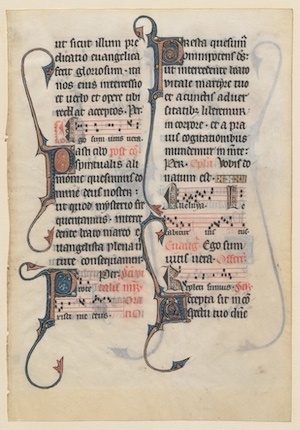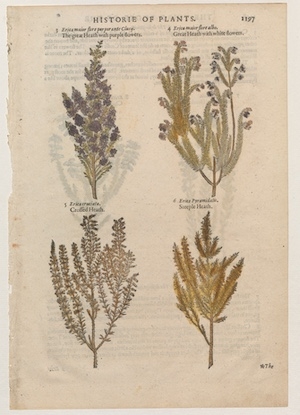Schaffer Library has digitized and made available online the contents of four portfolios of manuscripts and printed leaves, representing nine centuries of leaves from books across the centuries. The volumes were produced by Otto Ege, a noted book-breaker chiefly active in the 1940s. Motivated by his desire to make medieval manuscripts available to the general public, Ege would “break” manuscripts into individual leaves, mount them in mats (suitable for framing), and sell the leaves. Eventually he began compiling sets of these leaves into portfolios for personal use or library collections.
Union College’s Special Collections & Archives Library contains four of these portfolios, which are now available online through ARCHES. The story of Union College's Ege leaves stretches back to the 1940s, when three of the volumes, including most of the medieval leaves, were acquired. Originally cataloged on cards at the time, the records were eventually transferred to the Schaffer Library's online catalog. Serendipitously, the connections between these items and their importance in history was reestablished in 2022, and were immediately recognized as strong candidates for digitization.
Two of the Ege volumes are of his major portfolios -- Original leaves from famous books: eight centuries, 1240 A.D.-1923 A.D., and Original leaves from famous books: nine centuries, 1122 A.D. - 1923 A.D. These incorporate leaves from books across the centuries, with samples from medieval manuscripts, incunabula from the earliest period of the printing press, and notable publications as the printing industry evolved from hand press on handmade paper through various automated printing mechanisms, which also highlight the evolution of literary hands and printing fonts. The third volume, Original leaves from medieval manuscripts, is one of his earliest portfolio efforts, of which it is one of six known surviving examples. It incorporates five leaves, all medieval manuscripts. The last, Mms. leaves, 13th-15th centuries, consists of eight individually purchased leaves. These represent some of the best of his offerings, including a masterfully decorated leaf from the noted “Beauvais Missal” and a leaf from an English rendering of the Vulgate Bible with a prominent illuminated initial.
Digitization of these four volumes was completed by Schaffer Library’s Digital Services department, with the goals of enhancing classroom use as well as potentially digitally reuniting the materials within their original volumes. The history of these volumes and Ege’s work is complex, as Ege broke apart and dispersed individual manuscript leaves from the medieval period in the hopes of making them more accessible at a time when the only means of access was through the physical object, usually located in major library collections. The digitization and online presentation of these items now helps reconnect these materials and digitally reconstruct what was fragmented. By placing these digital images and descriptions online, Ege’s desire for broad access to the materials can be better realized by sharing them online. Meanwhile, the damage that Ege committed through his book breaking can be alleviated through the digital product; any digitized leaves can be digitally connected to allow users to view them in their original context. A key example is the case of the Beauvais Missal, a remarkable product of medieval illumination and decoration. Union College's leaf, besides being present here, is also reflected in a digital reconstruction available on the Fragmentarium website, a site that seeks to reunite these leaves digitally.
For more information about the Ege portfolios, contact Special Collections & Archives.

